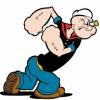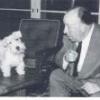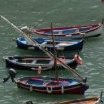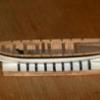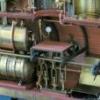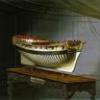Supplies of the Ship Modeler's Handbook are running out. Get your copy NOW before they are gone! Click on photo to order.
×
-
Posts
4,555 -
Joined
-
Last visited
Reputation Activity
-
 Blue Ensign got a reaction from EricWilliamMarshall in 18TH c. English Pinnace by Blue Ensign - FINISHED - Model Shipways - 1:24 scale
Blue Ensign got a reaction from EricWilliamMarshall in 18TH c. English Pinnace by Blue Ensign - FINISHED - Model Shipways - 1:24 scale
Thank you Bob, Grant, Michael, Martin, Steve, and Christian.
So this build is completed after a leisurely five month exercise.
The final item to make the base board and hull supports.
1034
For the base I have used a plain piece of Boxwood sheet of 3mm thickness with slightly chamfered edges.
1036
You may recognise what I enlisted into service for the supports.
1037
For a change I made a greater effort for the final photo shoot.
and here are the results.
0444
0448
0465
0475
0496
0497
1029
1038
1040
1044
1045
1046
1048
1049
1050
1053
1054
1056.
Thoughts on the Pinnace kit.
My thanks go to Chuck for designing this fine kit and giving us modellers the opportunity to build a nicely scaled model of an iconic 18th c boat.
This is a fine little model but a sod to plank, although I did use rather thin Boxwood strip which allowed a very small margin for sanding corrections .
The supplied basswood is not really suitable for a model of this single planked type being too soft and feathery to get clean edges. I did replace much of the wood with my stock Boxwood and were I to do it again I would use Boxwood overall albeit of a somewhat thicker strip for the exterior planking, allowing me a little more leeway for my planking deficiencies.
I wasn't too happy with my work at the outset but as the build progressed and I got into the detail I eased up on myself somewhat, a model is more than the sum of its parts, and although I don't rate it as one of my best efforts, I do rather like the look of it outside of the prying eye of the macro lens.
This has been a nice little five month summer project, not entirely relaxing, but with a satisfying result, and it has wetted my appetite for Chuck's forthcoming Barge kit.
Regards,
B.E.
-
 Blue Ensign got a reaction from GrandpaPhil in 18TH c. English Pinnace by Blue Ensign - FINISHED - Model Shipways - 1:24 scale
Blue Ensign got a reaction from GrandpaPhil in 18TH c. English Pinnace by Blue Ensign - FINISHED - Model Shipways - 1:24 scale
Thank you Bob, Grant, Michael, Martin, Steve, and Christian.
So this build is completed after a leisurely five month exercise.
The final item to make the base board and hull supports.
1034
For the base I have used a plain piece of Boxwood sheet of 3mm thickness with slightly chamfered edges.
1036
You may recognise what I enlisted into service for the supports.
1037
For a change I made a greater effort for the final photo shoot.
and here are the results.
0444
0448
0465
0475
0496
0497
1029
1038
1040
1044
1045
1046
1048
1049
1050
1053
1054
1056.
Thoughts on the Pinnace kit.
My thanks go to Chuck for designing this fine kit and giving us modellers the opportunity to build a nicely scaled model of an iconic 18th c boat.
This is a fine little model but a sod to plank, although I did use rather thin Boxwood strip which allowed a very small margin for sanding corrections .
The supplied basswood is not really suitable for a model of this single planked type being too soft and feathery to get clean edges. I did replace much of the wood with my stock Boxwood and were I to do it again I would use Boxwood overall albeit of a somewhat thicker strip for the exterior planking, allowing me a little more leeway for my planking deficiencies.
I wasn't too happy with my work at the outset but as the build progressed and I got into the detail I eased up on myself somewhat, a model is more than the sum of its parts, and although I don't rate it as one of my best efforts, I do rather like the look of it outside of the prying eye of the macro lens.
This has been a nice little five month summer project, not entirely relaxing, but with a satisfying result, and it has wetted my appetite for Chuck's forthcoming Barge kit.
Regards,
B.E.
-
 Blue Ensign reacted to Barbossa in 18TH c. English Pinnace by Blue Ensign - FINISHED - Model Shipways - 1:24 scale
Blue Ensign reacted to Barbossa in 18TH c. English Pinnace by Blue Ensign - FINISHED - Model Shipways - 1:24 scale
When hobby & craftmanship are becoming an art
Just outstanding work and inspiring as ever.
Sincere congrats
-
 Blue Ensign got a reaction from EricWilliamMarshall in 18TH c. English Pinnace by Blue Ensign - FINISHED - Model Shipways - 1:24 scale
Blue Ensign got a reaction from EricWilliamMarshall in 18TH c. English Pinnace by Blue Ensign - FINISHED - Model Shipways - 1:24 scale
Splashguards
I toyed with the idea of making replacements out of Boxwood, but on reflection I think the kit provided items are just fine, particularly as they are painted.
I did some preparatory painting before gluing the two elements together, the panel faces, and inner moulding edges. The guards were then sanded down to around 0.9mm in thickness.
Before fitting, the seat back needed some very careful paring back using a scalpel and light sanding. I also needed to shape down the backrest top to fall just below the splashguard top edges.
This all needs to be done with soft hands and by fine degrees, any slips at this point could prove problematic in restoration.
The guards require the water /heat treatment to impart some curve to follow the line of the rail. This is another exercise that requires some care.
It was good to have a spare unit in the kit as I did break one.
I was a little concerned that the water would weaken the pva, but immersion was only for a few seconds before pegging around a jar top to apply the heat.
On my Pinnace at least, two curves were required, a short one where the guard passed around the seat back, and a more gentle curve forward.
0968
Forming the aft curve.
0970
and the forward curve.
Getting the curve right is necessary for the guard to sit on the rail without tension, otherwise gluing it will be a difficult task.
0974
Once I was happy with the fit I painted the exterior face of the guard.
0975
To get a good grip it was necessary to scrape a paint free line along the top of the rail. This was carefully done with a scalpel point.
0981
The actual fitting of the guards was problem free with quick grab using full strength pva. The inside faces of the guards were painted once in place.
0982
0983
0984
So the Pinnace is effectively finished, some fettlin' to do, and a base to make which I don't think will take too long.
B.E.
-
 Blue Ensign got a reaction from iosto in 18TH c. English Pinnace by Blue Ensign - FINISHED - Model Shipways - 1:24 scale
Blue Ensign got a reaction from iosto in 18TH c. English Pinnace by Blue Ensign - FINISHED - Model Shipways - 1:24 scale
A small diversion to play with the boat equipment.
The Grapnel
The grapnel as provided by the kit seems to have been rigged without the benefit of a ring, the line secured directly thro' the eye in the shank where the ring should be.
A grapnel as illustrated by Steel shows a ring fitted thro' the eye.
Steel gives a grapnel rope circ for ships boats as 3" - 3½" which equates to around 1mm diameter line at scale.
0946
This alone would not be possible without a ring, particularly as the classic hitch for small anchors is a Fisherman's Bend where the line passes twice thro' the ring.
He also gives 35 fathoms as the length of the grapnel rope. which scales to 2667mm. This is 8.75ft at scale, where would all that fit in the boat!
0967(2)
I satisfied myself with a rope length of around 30' - 300mm which I figured would be long enough for what is essentially a harbour boat.
Boat Hook
This is shown on the plan but the makings are not included with the kit.
0950
Not too difficult an item to reproduce, I use a soft white metal strip (the arm from one of Mrs W's hair clips, cut and shaped with files, and inserted into a length of thin Walnut dowel.
0948
0964
0956
The Thole pins and chocks are also shown on these shots. Nothing much to say about the tholes except they are fiddly little things to make, parts very small, fingers too big.
I changed the style slightly from the plans, and left them unpainted as a contrast to the predominantly red scheme.
0961
Just the Splashguards left to do now.
B.E.
-
 Blue Ensign reacted to Tigersteve in 18TH c. English Pinnace by Blue Ensign - FINISHED - Model Shipways - 1:24 scale
Blue Ensign reacted to Tigersteve in 18TH c. English Pinnace by Blue Ensign - FINISHED - Model Shipways - 1:24 scale
I think he's tackling the 18th century longboat next. ;-)
Sfeve
-
 Blue Ensign reacted to md1400cs in 18TH c. English Pinnace by Blue Ensign - FINISHED - Model Shipways - 1:24 scale
Blue Ensign reacted to md1400cs in 18TH c. English Pinnace by Blue Ensign - FINISHED - Model Shipways - 1:24 scale
B.E.,
Just catching up - as usual brilliant work in such a small scale.
That hook tip is superb as well.
Your colors also work so well together.
Cheers,
-
 Blue Ensign reacted to gjdale in 18TH c. English Pinnace by Blue Ensign - FINISHED - Model Shipways - 1:24 scale
Blue Ensign reacted to gjdale in 18TH c. English Pinnace by Blue Ensign - FINISHED - Model Shipways - 1:24 scale
Congratulations on yet another fine piece of work B.E.
-
 Blue Ensign reacted to rafine in 18TH c. English Pinnace by Blue Ensign - FINISHED - Model Shipways - 1:24 scale
Blue Ensign reacted to rafine in 18TH c. English Pinnace by Blue Ensign - FINISHED - Model Shipways - 1:24 scale
I really like it B.E. A lovely piece of work.
Bob
-
 Blue Ensign got a reaction from CaptainSteve in 18TH c. English Pinnace by Blue Ensign - FINISHED - Model Shipways - 1:24 scale
Blue Ensign got a reaction from CaptainSteve in 18TH c. English Pinnace by Blue Ensign - FINISHED - Model Shipways - 1:24 scale
Splashguards
I toyed with the idea of making replacements out of Boxwood, but on reflection I think the kit provided items are just fine, particularly as they are painted.
I did some preparatory painting before gluing the two elements together, the panel faces, and inner moulding edges. The guards were then sanded down to around 0.9mm in thickness.
Before fitting, the seat back needed some very careful paring back using a scalpel and light sanding. I also needed to shape down the backrest top to fall just below the splashguard top edges.
This all needs to be done with soft hands and by fine degrees, any slips at this point could prove problematic in restoration.
The guards require the water /heat treatment to impart some curve to follow the line of the rail. This is another exercise that requires some care.
It was good to have a spare unit in the kit as I did break one.
I was a little concerned that the water would weaken the pva, but immersion was only for a few seconds before pegging around a jar top to apply the heat.
On my Pinnace at least, two curves were required, a short one where the guard passed around the seat back, and a more gentle curve forward.
0968
Forming the aft curve.
0970
and the forward curve.
Getting the curve right is necessary for the guard to sit on the rail without tension, otherwise gluing it will be a difficult task.
0974
Once I was happy with the fit I painted the exterior face of the guard.
0975
To get a good grip it was necessary to scrape a paint free line along the top of the rail. This was carefully done with a scalpel point.
0981
The actual fitting of the guards was problem free with quick grab using full strength pva. The inside faces of the guards were painted once in place.
0982
0983
0984
So the Pinnace is effectively finished, some fettlin' to do, and a base to make which I don't think will take too long.
B.E.
-
 Blue Ensign got a reaction from JpR62 in 18TH c. English Pinnace by Blue Ensign - FINISHED - Model Shipways - 1:24 scale
Blue Ensign got a reaction from JpR62 in 18TH c. English Pinnace by Blue Ensign - FINISHED - Model Shipways - 1:24 scale
Splashguards
I toyed with the idea of making replacements out of Boxwood, but on reflection I think the kit provided items are just fine, particularly as they are painted.
I did some preparatory painting before gluing the two elements together, the panel faces, and inner moulding edges. The guards were then sanded down to around 0.9mm in thickness.
Before fitting, the seat back needed some very careful paring back using a scalpel and light sanding. I also needed to shape down the backrest top to fall just below the splashguard top edges.
This all needs to be done with soft hands and by fine degrees, any slips at this point could prove problematic in restoration.
The guards require the water /heat treatment to impart some curve to follow the line of the rail. This is another exercise that requires some care.
It was good to have a spare unit in the kit as I did break one.
I was a little concerned that the water would weaken the pva, but immersion was only for a few seconds before pegging around a jar top to apply the heat.
On my Pinnace at least, two curves were required, a short one where the guard passed around the seat back, and a more gentle curve forward.
0968
Forming the aft curve.
0970
and the forward curve.
Getting the curve right is necessary for the guard to sit on the rail without tension, otherwise gluing it will be a difficult task.
0974
Once I was happy with the fit I painted the exterior face of the guard.
0975
To get a good grip it was necessary to scrape a paint free line along the top of the rail. This was carefully done with a scalpel point.
0981
The actual fitting of the guards was problem free with quick grab using full strength pva. The inside faces of the guards were painted once in place.
0982
0983
0984
So the Pinnace is effectively finished, some fettlin' to do, and a base to make which I don't think will take too long.
B.E.
-
 Blue Ensign got a reaction from popeye the sailor in Charles W Morgan by Landlubber Mike - Model Shipways - Scale 1:64 - New Bedford Whaling Bark
Blue Ensign got a reaction from popeye the sailor in Charles W Morgan by Landlubber Mike - Model Shipways - Scale 1:64 - New Bedford Whaling Bark
Nice progress Mike, that ebony finish is going to look great .
I too would take the higher copper line, and as for getting the Verdigris finish I understand urine is the way to go, who was it on MSW who made a great job using this method, having a senior moment, his name has slipped my mind.
Personally I quite like the old copper penny look.
B.E.
-
 Blue Ensign got a reaction from Martin W in Charles W Morgan by Landlubber Mike - Model Shipways - Scale 1:64 - New Bedford Whaling Bark
Blue Ensign got a reaction from Martin W in Charles W Morgan by Landlubber Mike - Model Shipways - Scale 1:64 - New Bedford Whaling Bark
Nice progress Mike, that ebony finish is going to look great .
I too would take the higher copper line, and as for getting the Verdigris finish I understand urine is the way to go, who was it on MSW who made a great job using this method, having a senior moment, his name has slipped my mind.
Personally I quite like the old copper penny look.
B.E.
-
 Blue Ensign got a reaction from DBorgens in 18TH c. English Pinnace by Blue Ensign - FINISHED - Model Shipways - 1:24 scale
Blue Ensign got a reaction from DBorgens in 18TH c. English Pinnace by Blue Ensign - FINISHED - Model Shipways - 1:24 scale
Splashguards
I toyed with the idea of making replacements out of Boxwood, but on reflection I think the kit provided items are just fine, particularly as they are painted.
I did some preparatory painting before gluing the two elements together, the panel faces, and inner moulding edges. The guards were then sanded down to around 0.9mm in thickness.
Before fitting, the seat back needed some very careful paring back using a scalpel and light sanding. I also needed to shape down the backrest top to fall just below the splashguard top edges.
This all needs to be done with soft hands and by fine degrees, any slips at this point could prove problematic in restoration.
The guards require the water /heat treatment to impart some curve to follow the line of the rail. This is another exercise that requires some care.
It was good to have a spare unit in the kit as I did break one.
I was a little concerned that the water would weaken the pva, but immersion was only for a few seconds before pegging around a jar top to apply the heat.
On my Pinnace at least, two curves were required, a short one where the guard passed around the seat back, and a more gentle curve forward.
0968
Forming the aft curve.
0970
and the forward curve.
Getting the curve right is necessary for the guard to sit on the rail without tension, otherwise gluing it will be a difficult task.
0974
Once I was happy with the fit I painted the exterior face of the guard.
0975
To get a good grip it was necessary to scrape a paint free line along the top of the rail. This was carefully done with a scalpel point.
0981
The actual fitting of the guards was problem free with quick grab using full strength pva. The inside faces of the guards were painted once in place.
0982
0983
0984
So the Pinnace is effectively finished, some fettlin' to do, and a base to make which I don't think will take too long.
B.E.
-
 Blue Ensign got a reaction from Martin W in 18TH c. English Pinnace by Blue Ensign - FINISHED - Model Shipways - 1:24 scale
Blue Ensign got a reaction from Martin W in 18TH c. English Pinnace by Blue Ensign - FINISHED - Model Shipways - 1:24 scale
Thanks Martin, both Mrs W and William are quite forgiving of my raiding of their respective possessions to serve in the shipyard.
Both Amati and Mantua do a range of period figures for 1:64 scale at around 25mm high. Artesania do a range of 27mm figures one of which I used to represent the ill fated Captain; Cmdr John Hamilton Gore on my Pegasus.
In the UK I use either Cornwall Model Boats, or the Model Dockyard, (both in Cornwall) but my 1:24 scale Pinnace figure I purchased from Dean's Marine.
Regards,
B.E.
-
 Blue Ensign got a reaction from Old Collingwood in HMS Fly by Dfell - FINISHED - Amati / Victory Models - Scale 1:64
Blue Ensign got a reaction from Old Collingwood in HMS Fly by Dfell - FINISHED - Amati / Victory Models - Scale 1:64
Nice shots Doug, you must be feeling well satisfied with her.
B.E.
-
 Blue Ensign got a reaction from mtaylor in SS Kaiser Wilhelm der Grosse 1897 by Mirabell61 - FINISHED - scale 1:144 - POF - first German four stacker of the Norddeutscher Lloyd line
Blue Ensign got a reaction from mtaylor in SS Kaiser Wilhelm der Grosse 1897 by Mirabell61 - FINISHED - scale 1:144 - POF - first German four stacker of the Norddeutscher Lloyd line
This has been a fabulous project to follow Nils, many congratulations on completion on yet another wonderful model.
Love your growing museum collection
B.E.
-
 Blue Ensign got a reaction from Landlubber Mike in 18TH c. English Pinnace by Blue Ensign - FINISHED - Model Shipways - 1:24 scale
Blue Ensign got a reaction from Landlubber Mike in 18TH c. English Pinnace by Blue Ensign - FINISHED - Model Shipways - 1:24 scale
Splashguards
I toyed with the idea of making replacements out of Boxwood, but on reflection I think the kit provided items are just fine, particularly as they are painted.
I did some preparatory painting before gluing the two elements together, the panel faces, and inner moulding edges. The guards were then sanded down to around 0.9mm in thickness.
Before fitting, the seat back needed some very careful paring back using a scalpel and light sanding. I also needed to shape down the backrest top to fall just below the splashguard top edges.
This all needs to be done with soft hands and by fine degrees, any slips at this point could prove problematic in restoration.
The guards require the water /heat treatment to impart some curve to follow the line of the rail. This is another exercise that requires some care.
It was good to have a spare unit in the kit as I did break one.
I was a little concerned that the water would weaken the pva, but immersion was only for a few seconds before pegging around a jar top to apply the heat.
On my Pinnace at least, two curves were required, a short one where the guard passed around the seat back, and a more gentle curve forward.
0968
Forming the aft curve.
0970
and the forward curve.
Getting the curve right is necessary for the guard to sit on the rail without tension, otherwise gluing it will be a difficult task.
0974
Once I was happy with the fit I painted the exterior face of the guard.
0975
To get a good grip it was necessary to scrape a paint free line along the top of the rail. This was carefully done with a scalpel point.
0981
The actual fitting of the guards was problem free with quick grab using full strength pva. The inside faces of the guards were painted once in place.
0982
0983
0984
So the Pinnace is effectively finished, some fettlin' to do, and a base to make which I don't think will take too long.
B.E.
-
 Blue Ensign got a reaction from Rudolf in 18TH c. English Pinnace by Blue Ensign - FINISHED - Model Shipways - 1:24 scale
Blue Ensign got a reaction from Rudolf in 18TH c. English Pinnace by Blue Ensign - FINISHED - Model Shipways - 1:24 scale
Splashguards
I toyed with the idea of making replacements out of Boxwood, but on reflection I think the kit provided items are just fine, particularly as they are painted.
I did some preparatory painting before gluing the two elements together, the panel faces, and inner moulding edges. The guards were then sanded down to around 0.9mm in thickness.
Before fitting, the seat back needed some very careful paring back using a scalpel and light sanding. I also needed to shape down the backrest top to fall just below the splashguard top edges.
This all needs to be done with soft hands and by fine degrees, any slips at this point could prove problematic in restoration.
The guards require the water /heat treatment to impart some curve to follow the line of the rail. This is another exercise that requires some care.
It was good to have a spare unit in the kit as I did break one.
I was a little concerned that the water would weaken the pva, but immersion was only for a few seconds before pegging around a jar top to apply the heat.
On my Pinnace at least, two curves were required, a short one where the guard passed around the seat back, and a more gentle curve forward.
0968
Forming the aft curve.
0970
and the forward curve.
Getting the curve right is necessary for the guard to sit on the rail without tension, otherwise gluing it will be a difficult task.
0974
Once I was happy with the fit I painted the exterior face of the guard.
0975
To get a good grip it was necessary to scrape a paint free line along the top of the rail. This was carefully done with a scalpel point.
0981
The actual fitting of the guards was problem free with quick grab using full strength pva. The inside faces of the guards were painted once in place.
0982
0983
0984
So the Pinnace is effectively finished, some fettlin' to do, and a base to make which I don't think will take too long.
B.E.
-
 Blue Ensign got a reaction from Gahm in 18TH c. English Pinnace by Blue Ensign - FINISHED - Model Shipways - 1:24 scale
Blue Ensign got a reaction from Gahm in 18TH c. English Pinnace by Blue Ensign - FINISHED - Model Shipways - 1:24 scale
Splashguards
I toyed with the idea of making replacements out of Boxwood, but on reflection I think the kit provided items are just fine, particularly as they are painted.
I did some preparatory painting before gluing the two elements together, the panel faces, and inner moulding edges. The guards were then sanded down to around 0.9mm in thickness.
Before fitting, the seat back needed some very careful paring back using a scalpel and light sanding. I also needed to shape down the backrest top to fall just below the splashguard top edges.
This all needs to be done with soft hands and by fine degrees, any slips at this point could prove problematic in restoration.
The guards require the water /heat treatment to impart some curve to follow the line of the rail. This is another exercise that requires some care.
It was good to have a spare unit in the kit as I did break one.
I was a little concerned that the water would weaken the pva, but immersion was only for a few seconds before pegging around a jar top to apply the heat.
On my Pinnace at least, two curves were required, a short one where the guard passed around the seat back, and a more gentle curve forward.
0968
Forming the aft curve.
0970
and the forward curve.
Getting the curve right is necessary for the guard to sit on the rail without tension, otherwise gluing it will be a difficult task.
0974
Once I was happy with the fit I painted the exterior face of the guard.
0975
To get a good grip it was necessary to scrape a paint free line along the top of the rail. This was carefully done with a scalpel point.
0981
The actual fitting of the guards was problem free with quick grab using full strength pva. The inside faces of the guards were painted once in place.
0982
0983
0984
So the Pinnace is effectively finished, some fettlin' to do, and a base to make which I don't think will take too long.
B.E.
-
 Blue Ensign got a reaction from EricWilliamMarshall in 18TH c. English Pinnace by Blue Ensign - FINISHED - Model Shipways - 1:24 scale
Blue Ensign got a reaction from EricWilliamMarshall in 18TH c. English Pinnace by Blue Ensign - FINISHED - Model Shipways - 1:24 scale
A small diversion to play with the boat equipment.
The Grapnel
The grapnel as provided by the kit seems to have been rigged without the benefit of a ring, the line secured directly thro' the eye in the shank where the ring should be.
A grapnel as illustrated by Steel shows a ring fitted thro' the eye.
Steel gives a grapnel rope circ for ships boats as 3" - 3½" which equates to around 1mm diameter line at scale.
0946
This alone would not be possible without a ring, particularly as the classic hitch for small anchors is a Fisherman's Bend where the line passes twice thro' the ring.
He also gives 35 fathoms as the length of the grapnel rope. which scales to 2667mm. This is 8.75ft at scale, where would all that fit in the boat!
0967(2)
I satisfied myself with a rope length of around 30' - 300mm which I figured would be long enough for what is essentially a harbour boat.
Boat Hook
This is shown on the plan but the makings are not included with the kit.
0950
Not too difficult an item to reproduce, I use a soft white metal strip (the arm from one of Mrs W's hair clips, cut and shaped with files, and inserted into a length of thin Walnut dowel.
0948
0964
0956
The Thole pins and chocks are also shown on these shots. Nothing much to say about the tholes except they are fiddly little things to make, parts very small, fingers too big.
I changed the style slightly from the plans, and left them unpainted as a contrast to the predominantly red scheme.
0961
Just the Splashguards left to do now.
B.E.
-
 Blue Ensign got a reaction from egkb in 18TH c. English Pinnace by Blue Ensign - FINISHED - Model Shipways - 1:24 scale
Blue Ensign got a reaction from egkb in 18TH c. English Pinnace by Blue Ensign - FINISHED - Model Shipways - 1:24 scale
Splashguards
I toyed with the idea of making replacements out of Boxwood, but on reflection I think the kit provided items are just fine, particularly as they are painted.
I did some preparatory painting before gluing the two elements together, the panel faces, and inner moulding edges. The guards were then sanded down to around 0.9mm in thickness.
Before fitting, the seat back needed some very careful paring back using a scalpel and light sanding. I also needed to shape down the backrest top to fall just below the splashguard top edges.
This all needs to be done with soft hands and by fine degrees, any slips at this point could prove problematic in restoration.
The guards require the water /heat treatment to impart some curve to follow the line of the rail. This is another exercise that requires some care.
It was good to have a spare unit in the kit as I did break one.
I was a little concerned that the water would weaken the pva, but immersion was only for a few seconds before pegging around a jar top to apply the heat.
On my Pinnace at least, two curves were required, a short one where the guard passed around the seat back, and a more gentle curve forward.
0968
Forming the aft curve.
0970
and the forward curve.
Getting the curve right is necessary for the guard to sit on the rail without tension, otherwise gluing it will be a difficult task.
0974
Once I was happy with the fit I painted the exterior face of the guard.
0975
To get a good grip it was necessary to scrape a paint free line along the top of the rail. This was carefully done with a scalpel point.
0981
The actual fitting of the guards was problem free with quick grab using full strength pva. The inside faces of the guards were painted once in place.
0982
0983
0984
So the Pinnace is effectively finished, some fettlin' to do, and a base to make which I don't think will take too long.
B.E.
-
 Blue Ensign got a reaction from Barbossa in 18TH c. English Pinnace by Blue Ensign - FINISHED - Model Shipways - 1:24 scale
Blue Ensign got a reaction from Barbossa in 18TH c. English Pinnace by Blue Ensign - FINISHED - Model Shipways - 1:24 scale
Splashguards
I toyed with the idea of making replacements out of Boxwood, but on reflection I think the kit provided items are just fine, particularly as they are painted.
I did some preparatory painting before gluing the two elements together, the panel faces, and inner moulding edges. The guards were then sanded down to around 0.9mm in thickness.
Before fitting, the seat back needed some very careful paring back using a scalpel and light sanding. I also needed to shape down the backrest top to fall just below the splashguard top edges.
This all needs to be done with soft hands and by fine degrees, any slips at this point could prove problematic in restoration.
The guards require the water /heat treatment to impart some curve to follow the line of the rail. This is another exercise that requires some care.
It was good to have a spare unit in the kit as I did break one.
I was a little concerned that the water would weaken the pva, but immersion was only for a few seconds before pegging around a jar top to apply the heat.
On my Pinnace at least, two curves were required, a short one where the guard passed around the seat back, and a more gentle curve forward.
0968
Forming the aft curve.
0970
and the forward curve.
Getting the curve right is necessary for the guard to sit on the rail without tension, otherwise gluing it will be a difficult task.
0974
Once I was happy with the fit I painted the exterior face of the guard.
0975
To get a good grip it was necessary to scrape a paint free line along the top of the rail. This was carefully done with a scalpel point.
0981
The actual fitting of the guards was problem free with quick grab using full strength pva. The inside faces of the guards were painted once in place.
0982
0983
0984
So the Pinnace is effectively finished, some fettlin' to do, and a base to make which I don't think will take too long.
B.E.
-
 Blue Ensign got a reaction from DCooper in 18TH c. English Pinnace by Blue Ensign - FINISHED - Model Shipways - 1:24 scale
Blue Ensign got a reaction from DCooper in 18TH c. English Pinnace by Blue Ensign - FINISHED - Model Shipways - 1:24 scale
Splashguards
I toyed with the idea of making replacements out of Boxwood, but on reflection I think the kit provided items are just fine, particularly as they are painted.
I did some preparatory painting before gluing the two elements together, the panel faces, and inner moulding edges. The guards were then sanded down to around 0.9mm in thickness.
Before fitting, the seat back needed some very careful paring back using a scalpel and light sanding. I also needed to shape down the backrest top to fall just below the splashguard top edges.
This all needs to be done with soft hands and by fine degrees, any slips at this point could prove problematic in restoration.
The guards require the water /heat treatment to impart some curve to follow the line of the rail. This is another exercise that requires some care.
It was good to have a spare unit in the kit as I did break one.
I was a little concerned that the water would weaken the pva, but immersion was only for a few seconds before pegging around a jar top to apply the heat.
On my Pinnace at least, two curves were required, a short one where the guard passed around the seat back, and a more gentle curve forward.
0968
Forming the aft curve.
0970
and the forward curve.
Getting the curve right is necessary for the guard to sit on the rail without tension, otherwise gluing it will be a difficult task.
0974
Once I was happy with the fit I painted the exterior face of the guard.
0975
To get a good grip it was necessary to scrape a paint free line along the top of the rail. This was carefully done with a scalpel point.
0981
The actual fitting of the guards was problem free with quick grab using full strength pva. The inside faces of the guards were painted once in place.
0982
0983
0984
So the Pinnace is effectively finished, some fettlin' to do, and a base to make which I don't think will take too long.
B.E.
-
 Blue Ensign got a reaction from oneslim in 18TH c. English Pinnace by Blue Ensign - FINISHED - Model Shipways - 1:24 scale
Blue Ensign got a reaction from oneslim in 18TH c. English Pinnace by Blue Ensign - FINISHED - Model Shipways - 1:24 scale
Splashguards
I toyed with the idea of making replacements out of Boxwood, but on reflection I think the kit provided items are just fine, particularly as they are painted.
I did some preparatory painting before gluing the two elements together, the panel faces, and inner moulding edges. The guards were then sanded down to around 0.9mm in thickness.
Before fitting, the seat back needed some very careful paring back using a scalpel and light sanding. I also needed to shape down the backrest top to fall just below the splashguard top edges.
This all needs to be done with soft hands and by fine degrees, any slips at this point could prove problematic in restoration.
The guards require the water /heat treatment to impart some curve to follow the line of the rail. This is another exercise that requires some care.
It was good to have a spare unit in the kit as I did break one.
I was a little concerned that the water would weaken the pva, but immersion was only for a few seconds before pegging around a jar top to apply the heat.
On my Pinnace at least, two curves were required, a short one where the guard passed around the seat back, and a more gentle curve forward.
0968
Forming the aft curve.
0970
and the forward curve.
Getting the curve right is necessary for the guard to sit on the rail without tension, otherwise gluing it will be a difficult task.
0974
Once I was happy with the fit I painted the exterior face of the guard.
0975
To get a good grip it was necessary to scrape a paint free line along the top of the rail. This was carefully done with a scalpel point.
0981
The actual fitting of the guards was problem free with quick grab using full strength pva. The inside faces of the guards were painted once in place.
0982
0983
0984
So the Pinnace is effectively finished, some fettlin' to do, and a base to make which I don't think will take too long.
B.E.


.thumb.jpeg.fc5d633a7b34428fcf19419a73d56d55.jpeg)


